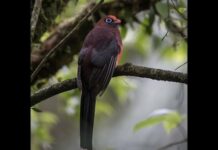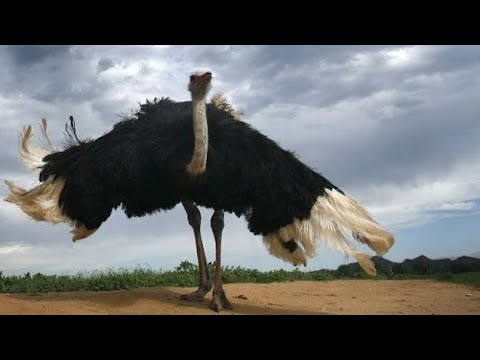The ostriches are a family, Struthionidae, of flightless birds. The two extant species of ostrich are the common ostrich and Somali ostrich, both in the genus Struthio, which also contains several species known from Holocene fossils such as the Asian ostrich. The common ostrich is the more widespread of the two living species, and is the largest living bird species. Other ostriches are also among the largest bird species ever.
Ostriches first appeared during the Miocene epoch, though various Paleocene, Eocene, and Oligocene fossils may also belong to the family.Ostriches are classified in the ratite group of birds, all extant species of which are flightless, including the kiwis, emus, and rheas. Traditionally, the order Struthioniformes contained all the ratites. However, recent genetic analysis has found that the group is not monophyletic, as it is paraphyletic with respect to the tinamous, so the ostriches are classified as the only members of the order
The earliest fossils of ostrich-like birds are Paleocene taxa from Europe. Palaeotis and Remiornis from the Middle Eocene and unspecified ratite remains are known from the Eocene and Oligocene of Europe and Africa. These may have been early relatives of the ostriches, but their status is questionable, and they may in fact represent multiple lineages of flightless paleognaths. The African Eremopezus, when not considered a basal secretarybird or shoebill, is sometimes considered an ostrich relative or an “aepyornithid-like” taxon. Apart from these enigmatic birds, the fossil record of the ostriches continues with several species of the modern genus Struthio, which are known from the Early Miocene onwards. Several of these fossil forms are ichnotaxa (that is, classified according to the organism’s footprints or other trace rather than its body) and their association with those described from distinctive bones is contentious and in need of revision pending more good material. While the relationship of the African fossil species is comparatively straightforward, many Asian species of ostriches have been described from fragmentary remains, and their interrelationships and how they relate to the African ostriches are confusing. In China, ostriches are known to have become extinct only around or even after the end of the last ice age; images of ostriches have been found there on prehistoric pottery and petroglyphs.
Ostriches have co-existed with another lineage of flightless didactyl birds, the eogruids. Though Olson 1985 classified these birds as stem-ostriches, they are otherwise universally considered to be related to cranes, any similarities being the result of convergent evolution. Competition from ostriches has been suggested to have caused the extinction of the eogruids, though this has never been tested and both groups do co-exist in some sites.
As with most other ratites, ostriches are believed to have developed flightlessness in the wake of the Cretaceous-Paleogene extinction event of about 66 Ma. The sudden absence of non-avian dinosaurs opened ecological niche space for large herbivorous animals and limited predatory threats, prompting volant ancestral paleognaths dispersed across the southern hemisphere to convergently lose the capability for flight.
Today ostriches are only found natively in the wild in Africa, where they occur in a range of open arid and semi-arid habitats such as savannas and the Sahel, both north and south of the equatorial forest zone. The Somali ostrich occurs in the Horn of Africa, having evolved isolated from the common ostrich by the geographic barrier of the East African Rift. In some areas, the common ostrich’s Masai subspecies occurs alongside the Somali ostrich, but they are kept from interbreeding by behavioral and ecological differences. The Arabian ostriches in Asia Minor and Arabia were hunted to extinction by the middle of the 20th century, and in Israel attempts to introduce North African ostriches to fill their ecological role have failed. Escaped common ostriches in Australia have established feral populations.
We are excited to present to you the captivating video titled “Biggest Bird Ostrich Ever”. Get ready to embark on a journey of enjoyment, smiles, and laughter as you watch this delightful creation. “Biggest Bird Ostrich Ever” is a perfect blend of entertainment and amusement, carefully crafted to bring joy to your day. From the moment you press play, you’ll be greeted with a cascade of lighthearted moments, heartwarming scenes, and perhaps even a few surprises that will tickle your funny bone.
Whether you’re in need of a quick pick-me-up or simply looking for some light-hearted entertainment, “Biggest Bird Ostrich Ever” has you covered. The video promises to deliver a collection of moments that are bound to leave you grinning from ear to ear. With its engaging content and skillful presentation, “Biggest Bird Ostrich Ever” is more than just a video – it’s an experience designed to brighten your mood and spread positivity.
The creators of “Biggest Bird Ostrich Ever” have poured their creativity and dedication into crafting a visual treat that resonates with audiences of all ages. Through expert storytelling, impeccable timing, and an array of engaging content, “Biggest Bird Ostrich Ever” promises to be an unforgettable journey that lingers in your memory long after the video concludes.
So sit back, relax, and prepare to be entertained as you dive into the world of “Biggest Bird Ostrich Ever”. It’s a delightful video that aims to bring a dose of happiness to your day, leaving you with a lasting smile and a heart full of laughter.
This video was uploaded in youtube and has recieved 31892 views so far. This is a great achievement and laso it has received 210 likes and .
Data bout the video:
Rating: ,
Video dimensions: 2d,
Video definition: hd,
Video duration: 00:01:05,
Video favourite count: 0
Video comment count: 14




















